|
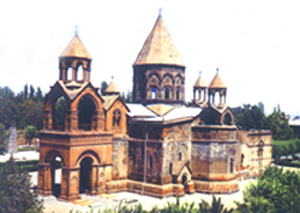
MAIN CATHEDRAL 303 A.D TOWN ECHMIADZIN
Echmiadzin is the spiritual capital of Armenia (Armenian Vatican). Here is the residence of the Head of the Armenian Apostolic Church - The Catholicos of all Armenians. In one of its numerous museums there are such relics as the piece of Noah's ark and the spear with which the Roman soldier pierced Jesus Christ's side. 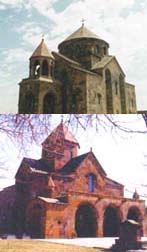
ST. GAYANE & St. RIPSIME
(603 A.D)TOWN ECHMIADZIN
The silhouettes of these unique churches form
a cupola basilica with the legendary Mount
Ararat in the background. These legendary
churches are dedicated to holy virgins Gayane
and Hripsime that according to the legend
sacrificed their lives for the defusion of
Christianity in Armenia. 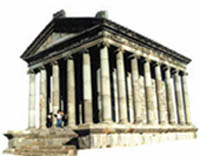
GARNI PAGAN TEMPLE (I c. B.C)
This unique pagan temple was devoted to one of the Armenian Pagan Gods - Mitra. After the adoption of Christianity the temple was used by Armenian royal families as their summer residence & hunting ground. The fantastic landscape of Garni shocks the human imagination. 
GEGHARD CAVE MONASTERY (10th c.)
This Monasteric complex dates back to 10-13 th centuries. "Geghard" means "lance" ("spear" in Armenian) and refers to the Biblical lance used by a Roman soldier to pierce Christ's body. The church is carved in the solid rock. This monastery has sheltered many outstanding scholars of ancient times. 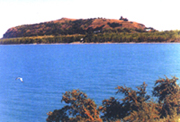
LAKE SEVAN
The majestic Lake Sevan, the biggest mountain lake in the world, is located at an altitude of 2000 m. above sea level. It is also called "the blue pearl of Armenia". Don't fail to cross the lake and visit the monastery (9th century) on the peninsula! 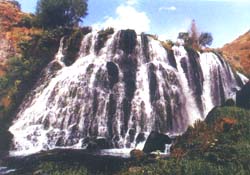
SHAKI WATERFALL
Located in Jermouk, a famous health resort, is situated at 2100 m above sea level. Jermouk's famous spring waters are used both for bathing and drinking and are highly recommended for many deseases. The beautiful landscape of this spa and its environment have very high curative values. 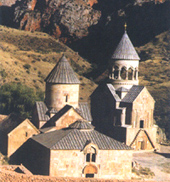
NORAVANQ MONASTERY (13th c.)
This monastery is considered to be the pulpit of Syunic province bishops of Armenia. The main church of St. Karapet and the 2 storied church to the South of the complex were built in the 13-th century. The tomb monuments surrounding the church date back to the 4-th & 5-th centuries. 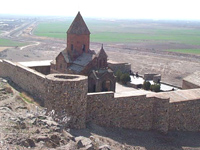
KHOR VIRAP (4th c.)
A mystical place of pilgrimage situated at the foot of the mount Ararat. The Armenian pagan King Trdat had imprisoned St. Gregory the Illuminator in Khor Virap ("deep pit" in Armenian) for preaching Christianity for 13 long years. This is the nearest point to the mount Ararat where Noah's ark landed according to the Bible. 
HAGHPAT MONASTERY COMPLEX (10th c.)
The complex used to be an important spiritual and scientific center of Medieval Armenia.The bell tower of the complex is a three-storeyed building, built in 1245. Inside the church there is a water pool that is believed to have curative qualities for people with poor health. The famous Armenian musician and poet Sayat-Nova spent here long 20 years, away from civilization. 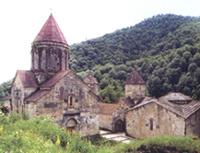
HAGHARTSIN MONASTERY (13th c.) The monastery is situated in an oak forest in the gorge of a small river.The monastery was built in 1248. Its oldest church is a cross-winged dome named after St.Gregory. The refectory of Haghartsin is very unique in character.
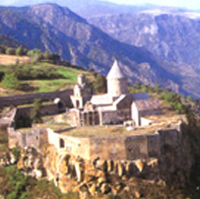
TATEV MONASTERY (11th c.)
The monastery is a unique architectural complex, and is one of the most significant monuments of medieval Armenia. It was built on the place of a pagan temple and is surrounded by a precipice from three sides. Tatev monastery had significant land possessions and used to have vast incomes thanks to duties collected from neighboring villages. It used to be an important scholastic center and had a higher school for monks and a depository of thousands of manuscripts. The main cathedral Poghos-Pedros /Paul and Peter/ dates back to 805-906. The other church St. Virgin was built in the 11th c. 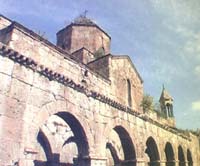
ODZUN CATHEDRAL (6th c.)
The cathedral is a magnificent specimen of Armenian architecture of the early Christian period.This Cathedral has retained its original look to the present day. The monastery, made of red and white felsite stone, presents a cross-domed basilica. The burial site of the famous Armenian prince and hero Smbat Bagratuni is here. 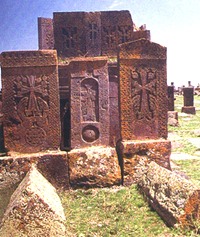
KHACHKARS (Cross Stones in Armenian)
Khachkar or Cross Stone is the unique manifestation of Christian Armenian national art which in its Christian form and type has no other equivalent in the world. There are about 300,000 handmade khachqars in Armenia unlike each other. Noraduz is a "forest of kachkars", dating as far back as the 8th century. 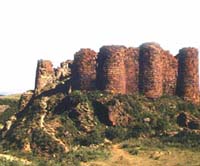
AMBERD FORTRESS (10th c.)
Amberd is a medieval castle and town-fortress. It was built in the 10c., 7 km away from Byurakan village, on the place of fusion of the rivers Amberd and Arkashen, on a triangular cape, 2300 m above the sea level. The palace and some parts of its walls were built in the 7c. Amberd one of the important military strong points of the time. The church, the bathhouse, some ruins of the palace and the walls of Amberd have been preserved to our times. 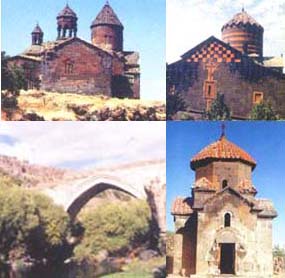
TOWN ASHTARAK
Famous scientific center of Armenia. River Kasakh, spaned by a 5th c. bridge welcomes you at the entrance to Ashtarak. The nice three-arched bridge is built of apricot-colored tufa stone. Surprising churches of Karmravor (7th c.), Marine (13th c.), Mughni (10th c.), Saghmosavanq (12-13th c.), Ohanavanq (5-13th c.) are also located in Ashtarak. 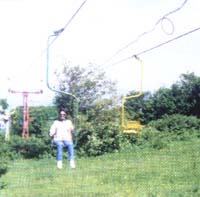
TOWN TSAKHKADZOR (Valley of Flowers)
Tsakhkadzor is one of the most popular resorts of Armenia for summer and winter. This is a perfect place to admire the beauty of Armenian high mountains and the valleys of flowers. One can find many amusements here to fill his leisure time with joy and excitement; swimming pools, cafes, games and a funicular railway that connects the resort with the surrounding hills all covered with forests. In winter it is turned into a wonderful skiing place. 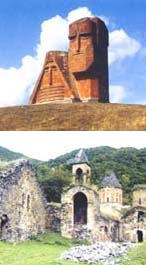
NAGORNO - KARABAKH
Artsakh or Nagorno-Karabakh (Mountainous Kharabakh) is a region of Armenia. Kharabakh is a typical mountainous country. Places of habitations and cemeteries of the Stone, Bronze and Iron Ages were found on its territory. There are numerous valuable complexes of Middle Ages in Kharabakh: Gandzasar, a full functioning monastery (13-17 cc.), Amaras church (5-19 cc.), Gtich (13 c.), Dadivank (12-13 cc.), Yeghish Arakyal (13 c.), and some fortresses. Stepanakert and Shushi are the chief towns. |



